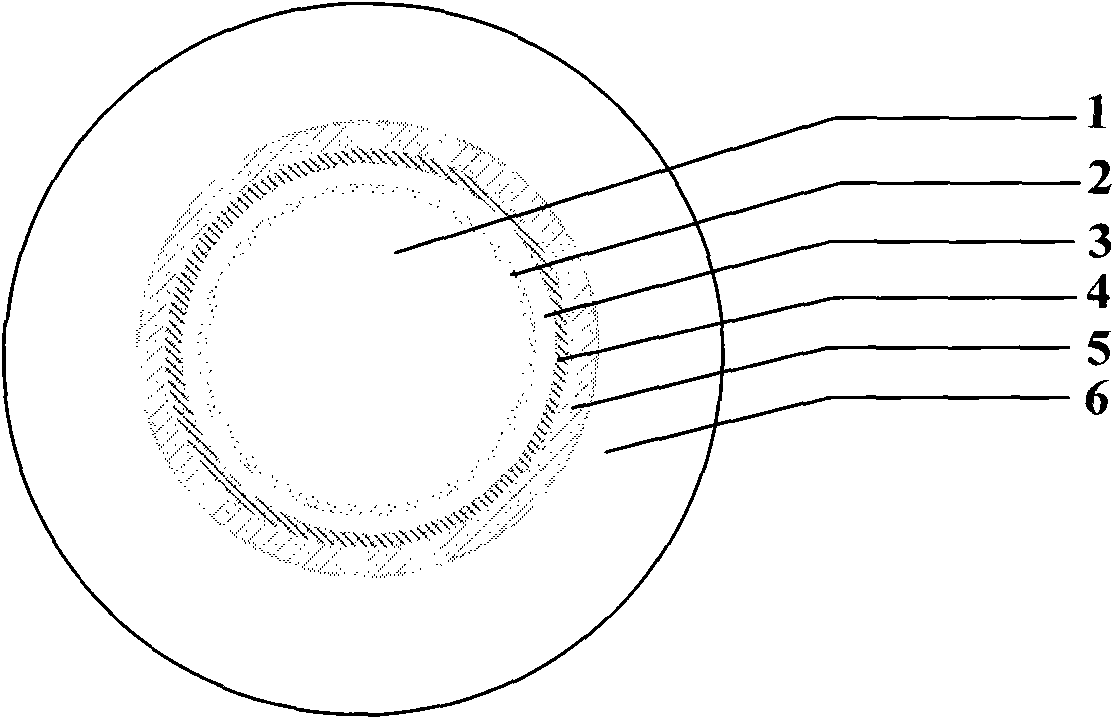Inner-wall waveguide mode capillary fiber based online evanescent field biosensor
A biochemical sensor and capillary technology, applied in the direction of optical waveguide light guide, optical waveguide coupling, cladding fiber, etc., can solve the constraints of the integration, miniaturization and stabilization of the optical fiber biochemical sensing system, and affect the stability and service life of the probe. , the limited load of the sensor probe, etc., to achieve the effect of high signal stability, improved mechanical strength, and improved sensitivity
- Summary
- Abstract
- Description
- Claims
- Application Information
AI Technical Summary
Problems solved by technology
Method used
Image
Examples
Embodiment 1
[0039] Example 1: Inner wall waveguide capillary fiber optic cyanide sensor based on CdSe quantum dot modification
[0040] Fully mix a certain amount of tetraethyl orthosilicate, absolute ethanol, and KH-560 in a certain proportion in a 25ml round-bottom beaker, and heat the mixed solution in a water bath at a temperature of 60°C. During the heating process, add 0.1 mol / L dilute hydrochloric acid solution dropwise to adjust the pH to 3, then install a condenser tube and start stirring on a magnetic stirrer. After about 40 minutes, the mixed solution began to form a uniform phase. At this time, TOPO-CdSe quantum dots were added, and the stirring was continued. With the extension of the reaction time, the state changed from the original dilute solution to a viscous liquid. After reacting for 1 hour, the sol was removed from the capillary fiber to form a sensitive layer 2 .
[0041] The detection of cyanide will be based on the anti-quenching principle. Aspirate the capillary ...
Embodiment 2
[0042] Example 2: Inner wall waveguide capillary fiber optic DNA sensor based on biomolecular modification
[0043] First use HNO 3 The surface of the ring waveguide 3 is activated, and then the inner surface of the optical fiber is silanized with 3-aminopropyltriethoxysilane (APTMS), so that the surface has amino groups. Adding a molecule capable of linking two positively charged molecules such as glutaraldehyde, adding Streptavidin. Finally, add biotin (Biotin) oligo-stranded DNA molecules such as 5'-biotin-CAGCGAGGTGAAAACGACAAAAGGGG solution. Finally, the DNA hybridization experiment is carried out, and the single-stranded gene fragment labeled with the fluorophore Cy3 passes through the sensing optical fiber fixed with a sensitive membrane. If the DNA fragment structure is: 5′-Cy3-CCCCTTTTGTCGTTTTCACCTCGCTG, the structure is captured by the base pairing reaction. The excitation light excites Cy3 to generate fluorescence through the evanescent field, and the signal is als...
PUM
| Property | Measurement | Unit |
|---|---|---|
| diameter | aaaaa | aaaaa |
| thickness | aaaaa | aaaaa |
| thickness | aaaaa | aaaaa |
Abstract
Description
Claims
Application Information
 Login to View More
Login to View More - R&D
- Intellectual Property
- Life Sciences
- Materials
- Tech Scout
- Unparalleled Data Quality
- Higher Quality Content
- 60% Fewer Hallucinations
Browse by: Latest US Patents, China's latest patents, Technical Efficacy Thesaurus, Application Domain, Technology Topic, Popular Technical Reports.
© 2025 PatSnap. All rights reserved.Legal|Privacy policy|Modern Slavery Act Transparency Statement|Sitemap|About US| Contact US: help@patsnap.com



